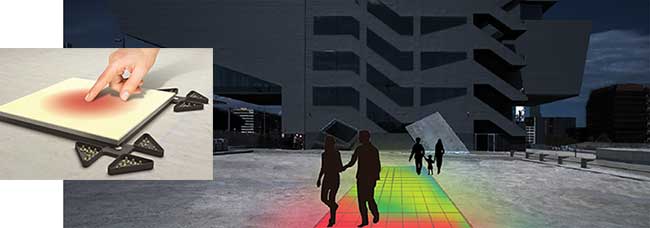Imagine changing the color of a bedroom or bathroom with the touch of a button. Envision transforming a living room into the inside of an art gallery or a ceiling into a movie theater.
Italian scientists are using pioneering photonics technology to make these possibilities reality with the Luminous Electronic Tile — LUMENTILE— project, combining the simplicity of a plain ceramic tile with the sophistication of today’s touchscreen technology.
Guido Giuliani, associate professor of optoelectronics at the University of Pavia, told Photonics Media this is the first time anyone has tried to embed electronics into ceramics or glass for a large-scale application, and that photonics and electronics are key to this product and future smart applications.

A walkable, sensorized floor of LUMENTILE. This will be installed in a public place, like a square or a shopping mall, and will be made of luminous tiles equipped with pressure sensors capable to detect a person walking onto the tile. Smart tiles for the future (inset). Courtesy of LUMENTILE Project.
“LUMENTILE exploits state-of-the-art commercial high-brightness, high-power RGB LEDs for making the tiles luminous and bright, and obviously color-changing,” said Giuliani. “In addition, we are developing a proprietary technology for the so-called ‘light management,’ that is, making the light emitted by single LEDs diffuse uniformly throughout the entire tile surface while keeping a high optical efficiency and a low-cost production process.”
A combination of ceramic, glass and organic electronics, the tile is made up of structural materials, solid-state light sources and electronic chips that can be controlled with a central computer, smartphone or tablet.
The thinking behind this is that it will be an option to consumers as part of the initial architect and design process in a house. Specifications will be set by the users and not by the electrical engineers.
“You are instantly in control of your own environment. If you like flowery wallpaper, ducks or Christmas trees, now you can change it with one tap,” Guiliani said.
Decorating is not the only use scientists see for the Luminous Electronic Tile. Potentially, the tiles could be used for advertising outside of a building, camouflaging military vehicles at the flick of a switch and as smart floor panels to, for example, recognize when an elderly user is no longer standing or has perhaps fallen.
The LUMENTILE product will be enhanced to include flexible, bendable and possibly wearable structures, while improving the ruggedness and applicability to smart-city environments. Giuliani said the possibilities are endless.
“We believe that LUMENTILE products will go on the market by 2020 with large-scale production and installations in shopping malls, airport terminals, public spaces, new building covers and private houses,” he said.
By the end of this year, Giuliani and his fellow LUMENTILE partners from Italy, Finland, Switzerland and Spain expect to go live with two or three installations in public places aimed at customers who want to be the first to have this technology.
The tiles will have the capability of being switched off to a default color setting of basic silver, black or white. Just as easily as they are turned off, they can be turned on to transform a dining room into, let’s say, the Taj Mahal. One could literally redecorate the inside of a house every single day.
Now, imagine this technology on the outside as well. Local homeowner’s associations wouldn’t be too happy.